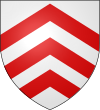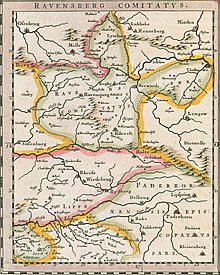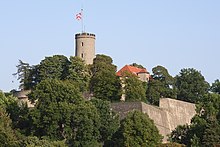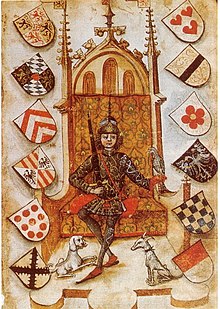Ravensberg county
|
Territory in the Holy Roman Empire |
|
|---|---|
| Ravensberg county | |
| coat of arms | |

|
|
| map | |

|
|
| Contemporary card from the 17th century
|
|
| Form of rule | county |
| Ruler / government | Count |
| Today's region / s |
DE-NW
|
| Reichskreis | Lower Rhine-Westphalian |
| Capitals / residences | Bielefeld |
| Dynasties | 1140–1346 Counts of Ravensberg 1346–1511 House Jülich 1511–1609 House Mark 1609 / 1614–1806 / 1918 House Hohenzollern |
| Denomination / Religions | Roman Catholic , Protestant from the 16th century |
| Language / n |
German
|
| Incorporated into |
Kingdom of Westphalia
|
The county of Ravensberg was a territory of the Holy Roman Empire and arose in the 12th century. It was in the east of the Lower Rhine-Westphalian Empire , with the city of Bielefeld as the capital. Originated in the 12th century, it was associated with Berg from 1346 , with Jülich-Berg from 1437 and with Kleve in the United Duchies from 1521 . After the provisional division of the estate in 1614, it was administered by Brandenburg-Prussia , to which it was added in 1666 with the final division of the estate. 1719 reorganized its territories and merged the county with the Principality of Minden as Minden-Ravensberg . In 1807 the territory became part of the new Kingdom of Westphalia , and in 1810 France annexed the first parts of the area.
Location and area
geography
The county was divided into four parts by several mountain ranges of the lower Weserbergland . In the north near Preußisch Oldendorf it reached beyond the Wiehen Mountains into the North German Plain . To the south of the Teutoburg Forest , around Halle and Brackwede , Ravensberg had a share in the Westphalian Bay . The area in the east around Vlotho and today's Bad Oeynhausen lay beyond the foothills of the Lipper Bergland on the Weser . The irregular territorial borders towards Minden also caused the peripheral location of these areas; before Herford was incorporated into Ravensberg, it had formed an exclave . The core area between the aforementioned ridges, around the cities of Bielefeld (main part), Herford and Bünde , was part of the Ravensberger Mulde , which later owes its name to the county. In addition, the area of the county largely coincides with the region known today as the Ravensberger Land .
Neighboring territories
In July 1806 the county bordered in the east on the principalities of Lippe , in the south on the rule Rheda (zu Bentheim-Tecklenburg ) and the county Rietberg. The rest was surrounded by other Prussian areas. u. a. the Principality of Minden in the north and the Reckenberg office .
In 1801, the territories around the county were fragmented. At that time, the county bordered the Principality of Minden in the north . In the east it bordered on the county of Lippe . In the south were the prince-bishopric of Paderborn , the county of Rietberg , the Osnabrück exclave Amt Reckenberg and the rule of Rheda , in the south-west the prince-bishopric of Münster . In the west, the principality of Osnabrück bordered the county. The tiny area of the Herford abbey in the city of Herford was also enclosed, but no territory in the narrower sense was assigned to it.
Current affiliation
The Ravensberg territory is located in what is today the administrative district of Detmold ( East Westphalia-Lippe ) in North Rhine-Westphalia . Based on its last valid borders (1652–1807) it is divided into the districts of Gütersloh , Herford , Minden-Lübbecke and the city of Bielefeld . In detail, the area of the following cities and municipalities belonged to it:
- Of the 13 municipalities in the Gütersloh district, five whole and one smaller part:
Borgholzhausen , Halle , Steinhagen , Versmold , Werther ; the Gütersloh district of Isselhorst .
- Of the nine municipalities in the Herford district, four whole, three mostly, one smaller:
Enger , Hiddenhausen , Rödinghausen , Spenge ; Herford without the Falkendiek district, Bünde without the Dünne and Spradow districts , Vlotho without the Uffeln district; Kirchlengern south of the Werre. - of the eleven municipalities in the Minden-Lübbecke district, one predominantly and one roughly half:
Preußisch Oldendorf without the districts of Hedem and Lashorst; Bad Oeynhausen south of the Werre. - the independent city of Bielefeld entirely.
history
meaning
The County of Ravensberg was not insignificant despite its small size. Due to the predominantly fertile soil, it was comparatively densely populated and had a favorable traffic situation between the west and the north of central Germany. It was also at the intersection (and therefore at the same time on the edge) of the areas of the surrounding competing Westphalian bishoprics of Minden , Paderborn , Münster and Osnabrück , which enabled it to keep itself free from one-sided dominance by one of these powers.
Based on these not unfavorable conditions, the Counts of Ravensberg managed to expand their territory slowly but steadily in the Middle Ages , despite some setbacks. This rise did not end until the county came into personal union with larger territories from the 14th century and the rulers turned their main political attention to other locales.
In terms of military strategy and as a source of money, Ravensberg continued to be important. This was especially true during the rule of the Hohenzollerns , for whom the county was an important link to their remote western possessions of Kleve and Mark . Brandenburg-Prussia also benefited significantly financially from the flourishing of the linen industry and trade in and around Bielefeld in the 17th and 18th centuries.
Event history

The foundations of the County of Ravensberg were created when the Counts of Calvelage , wealthy around Vechta and Bersenbrück , acquired areas in the Teutoburg Forest northwest of Halle around 1100 and built Ravensberg Castle. Otto (I.) moved his headquarters to the castle around 1140 and from then on carried the title "Graf von Ravensberg", as did all his successors.
During the 12th century, both the old and the new possessions (in the area around Bielefeld, Herford and Halle) could be expanded and additional ones acquired in the Emsland . The Counts of Calvelage-Ravensberg belonged to the most important noble families in Westphalia and fought in the north with the bishops of Munster , those of Osnabrück and especially the Counts of Tecklenburg for supremacy.
In 1226 the area was divided: Count Ludwig received the possessions around the Teutoburg Forest, his brother Otto II. Vlotho and the areas in the north. Otto died in 1244 without a male heir, his daughter Jutta sold the goods around Vechta and in the Emsland to Münster in 1252, which established the Lower Monastery of Münster , Vlotho fell to Tecklenburg. Thus limited to its area in East Westphalia, Ravensberg sank to a subordinate power.
Bielefeld , first mentioned as a city in 1214, developed into the capital of the county. Count Ludwig had the Sparrenburg built by around 1250 , which was the preferred seat of the rulers for the next hundred years. This was also the time of slow recovery: Vlotho fell back to Ravensberg around 1270, around 1300 the north-western areas around Limberg Castle and in 1334 Bünde were acquired.
This development ended in 1346: with the death of Count Bernhard , the Calvelage-Ravensberg family died out in the male line. Heiress was Bernhard's niece Margarete , married to a relative from the Jülich family. As Gerhard I, he became the new Count, and in 1348 also Count von Berg . From then on, Ravensberg was in close contact with Berg and soon Jülich as well .
From 1389, Wilhelm I , who was made Duke of Berg in 1380, transferred the county to two of his sons one after the other. While it only served Adolf as a basis for further expansion of personal power, Wilhelm II made more contributions to the county itself and in 1409 acquired Enger. With him a count had his residence for the last time on the Sparrenburg and his burial place in the Neustädter Marienkirche . When his son Count Gerhard II inherited the duchies of Jülich and Berg in 1437, Ravensberg finally became a mere outlying area within larger territorial alliances.
In 1511/21 Jülich-Berg-Ravensberg was connected with Kleve-Mark to Jülich-Kleve-Berg by inheritance . The dukes were tolerant of the ideas of the Reformation , which had spread in Ravensberg since around 1525, so that here the population gradually, but finally until 1600, completely converted to Lutheranism . When the ducal house died out in 1609, the Jülich-Klevian succession dispute broke out . The inheritance comparison in 1614 brought Ravensberg together with Kleve and Mark to Brandenburg (-Prussia) .
During the Thirty Years War , troops from almost all warring parties crossed the strategically important county, and the state castles were besieged several times. The peace treaty in 1648 brought Brandenburg as a favorable territorial reinforcement and rounding off the principality of Minden, which is neighboring the county . In addition, there was the imperial city of Herford , which was annexed in 1652 due to controversial claims and made into Ravensberg. From 1719 Minden and Ravensberg formed the administrative unit Minden-Ravensberg with its seat in Minden .
In the course of the reorganization of Germany by Napoleon I , the county of Ravensberg was incorporated into the Kingdom of Westphalia (Canton Bielefeld in the department of the Weser ) in 1807 , in 1811 the north and west fell directly to France (mostly district of Minden in the department of the Upper Ems ); from 1811 the remainder formed the majority of the Bielefeld Paderborn district in the still Westphalian department of Fulda . In 1813, as a result of the Wars of Liberation , Prussia regained the area and initially symbolically restored the county; this had no administrative effects within the civil government between the Weser and the Rhine .
The county of Ravensberg finally ceased to exist in 1816, its area was divided into the newly formed districts of Bielefeld , Halle (Westphalia) , Herford and Bünde (with smaller minimum shares) and small parts of Rahden . The districts belonged to the administrative district of Minden and thus to the province of Westphalia . Since 1969/73 the Ravensberg areas have been divided like the above.
In 1919 the county served as the namesake of the Ravensberg Catholic Student Association in the Cartel Association of Catholic German Student Associations in Münster.
organization



In the Holy Roman Empire
The county Ravensberg was not since 1437 at the latest reichsunmittelbar and the Empire days represented, as it has since in personal union with the duchies of Jülich and Berg stood and made their by-country.
This connection was considered broken in the course of the 17th century, so in 1705 Prussia applied for a seat on the Westphalian Count's Bank for Ravensberg . The proceedings at the Reich Chamber of Commerce did not come to an end until the end of the Reich.
Since the division of the realm into realm circles in 1500 Ravensberg belonged to the Lower Rhine-Westphalian realm circle .
In the first half of the 12th century, Count Hermann I, as a feudal bearer under Lothar von Süpplingenburg, acquired the count's rights in the Frisian Emsgau. These count rights were given to the bishops of Münster in 1253/54.
coat of arms
The Ravensberg coat of arms contained three red rafters in silver (white). It was always part of the coat of arms of the ruling houses owned by the county, most recently the large Prussian coat of arms . Today it can be found in several district and city coats of arms of the area, such as those of Bielefeld , Spenges , Borgholzhausen , Halles , Steinhagens , Vlothos , Werthers and the districts of Gütersloh and Minden-Lübbecke .
State castles
Ravensberg had five castles that were owned by the sovereigns:
- Sparrenburg ( Sparrenberg Castle) in Bielefeld, long seat of the counts; restored today;
- Ravensberg Castle near Borgholzhausen, the nucleus of the county; received in parts;
- Limberg Castle near Preußisch Oldendorf, partially restored;
- Vlotho Castle in Vlotho; Ruin (reproduced in 1936/39 on remains of the foundation);
- Bustedt Castle near Hiddenhausen, restored.
In addition to military security, the castles (with the exception of Bustedt) also served as the seat of the county’s administrative offices , so the four respective administrative areas (offices) were named after the castles. By the end of the 17th century at the latest, the buildings no longer met the military requirements and mostly fell into disrepair. Burgraves were assigned to each castle that served as the administrative seat , but they did not stand above Drosten as head of the offices.
organization


The county is divided into four offices named after the state castles (deviation: Office Sparrenberg based on Sparrenburg ) and the cities of Herford and Bielefeld. Until 1802 the tiny abbey of Herford (without territory in the strict sense) was not part of the county, after that it was part of the city of Herford. The seat of the Droste (bailiff) was later not always the castle. The Drost of the Sparrenberg Office was Landdrost and thus the highest of the Drosten. Furthermore, the office was divided into bailiffs with a bailiff at the head. The bailiwicks were divided into parishes and farmers. From 1652 - after the free imperial city of Herford was incorporated - the county was formally structured as follows:
- City of Bielefeld
- City of Herford (until 1802 without Herford abbey )
-
Ravensberg Office
- Bailiwick of Halle
- Versmold Bailiwick
- Vogtei Borgholzhausen
-
Office Sparrenberg
- Vogtei Werther
- Parish Werther, Dornberg (from around the end of the 17th century)
- Bailiwick of Heepen
- Parish of Heepen and parts of the parish of Oerlinghausen
- Bailiwick of Schildesche
- Schildesche parishes, Jöllenbeck
- Vogtei Brockhagen (until around the end of the 17th century)
- Parish Brockhagen (later Vogtei Brackwede)
- Bailiwick of Brackwede
- Parishes Brackwede, Isselhorst , Dornberg (until around the end of the 17th century), Steinhagen , Brockhagen (from around the end of the 17th century)
- Bailiwick Enger
- Parishes of Enger, Spenge , Hiddenhausen , Wallenbrück
- Vogtei Werther
- Limberg Office
-
Office of Vlotho
- Bailiwick of Vlotho
- Bailiwick of Wehrendorf
In the course of time there have been hardly any changes to this structure. Up until the second half of the 17th century, the Brockhagen parish was its own bailiwick. When this was repealed it came to the Vogtei Brackwede.
The bailiwicks of the offices of Ravensberg, Limberg and Vlotho had their importance until 1722/23 at the latest - shortly after the creation of the administrative area of Minden-Ravensberg and when the Drosten were largely relieved of their duties (not their office or honorary title) by the Prussian king facto largely lost, but formally continued to exist. In the Sparrenberg office, however, a different development emerged. Since it was relatively large, the importance of the bailiwicks developed and were given a bailiff at their head. Therefore, the term office became established for these bailiwicks . The bailiff of the former offices of Ravensberg, Limberg and Vlotho as well as the quasi-offices of Werther, Heepen, Schildesche, Brockhagen, Brackwede and Enger each received the income of an office from domains, mills, tithes , etc. for 6 years . He had to lease the office for it (Lease Office). He was also responsible for the judiciary of the first instance and police violence in the office.
The two newly established districts developed an important function after 1723, each of which was headed by a district administrator from around 1733. In Ravensberg, as in other Prussian areas, the formation of circles was initially dispensed with. In Ravensberg the offices of Limberg and Vlotho formed a district, as well as the office of Sparrenberg and the office of Ravensberg. The following district administrators are known:
- around 1733–1785: Johann Henrich Dietrich von Korff
- 1785–1796: Dietrich Victor Ludwig von Korff (successor to his brother Johann Henrich Dietrich von Korff)
- 1796– ?: von Quernheim (successor to von Korff)
- ...
- around 1733 to June 17, 1767: von Eller
- 1768–1771: from Ledebur to Crollage (successor to von Eller)
- 1771-12. May 1797: Vincke at Kilver
- ...
List of the Counts of Ravensberg

Note: There are different statements in the literature on the period of reign of the early counts.
House Calvelage-Ravensberg
emerged from the Counts of Calvelage and held their possession until 1252
- Until 1144 Hermann I.
- approx. 1140 – approx. 1170 Otto I.
- approx. 1160 – approx. 1180 Heinrich
- approx. 1175 – approx. 1220 Hermann II.
- approx. 1220-1244 Otto II . ; from 1226 only in Vlotho and Vechta
- approx. 1220–1249 Ludwig ; from 1226 only prevails in Ravensberg
- 1249-1306 Otto III.
- 1306-1328 Otto IV.
- 1328-1346 Bernhard
House Jülich (-Heimbach)
1348–1395 in personal union with Berg , from 1437 with Jülich-Berg
- 1346-1360 Gerhard I.
- 1360-1408 Wilhelm I ; From 1395 the county transfers two sons one after the other
- 1395-1402 Adolf
- 1402–1428 Wilhelm II.
- 1428–1475 Gerhard II.
- 1475–1511 Wilhelm III.
House (Cleves) Mark
from 1521 as ruler of Jülich-Kleve-Berg ; 1609–1614 Jülich-Klevian succession dispute
- 1511–1539 Johann
- 1539–1592 Wilhelm (IV.)
- 1592–1609 Johann Wilhelm
House of Hohenzollern
Electors of Brandenburg and Prussian kings
- 1614–1619 Johann Sigismund
- 1619–1640 Georg Wilhelm
- 1640–1688 Friedrich Wilhelm
- 1688-1713 Friedrich III .; from 1701 as Frederick I King in Prussia
- 1713–1740 Friedrich Wilhelm I.
- 1740–1786 Frederick II.
- 1786–1797 Friedrich Wilhelm II.
- 1797–1807 Friedrich Wilhelm III.
Even after the end of the county, the kings of Prussia carried the title Graf zu Ravensberg , most recently Kaiser Wilhelm II until 1918.
See also
literature
- Sebastian Sigler , Friedrich Korte: Bielefeld and the Counts of Ravensberg. The founding period from 1214 to 1346 . Hans Gieselmann Verlag, Bielefeld 2014. ISBN 978-3-923830-89-3 .
Web links
- Search for Grafschaft Ravensberg in the German Digital Library
- Information on the Grafschaft Ravensberg in the catalog of the German National Library
- Search for Grafschaft Ravensberg in the SPK digital portal of the Prussian Cultural Heritage Foundation
- Documents from the archive of the Grafschaft Ravensberg / digital Westphalian documents database (DWUD)
- Historical summary
- the rulers of Jülich (as such 1346–1511 also Counts of Ravensberg)
- Ravensberg coat of arms
- Family coat of arms of the Counts of Ravensberg in the coat of arms of the Westphalian nobility
Individual evidence
- ^ Leopold von Ledebur (ed.): New general archive for the history of the Prussian state. Mittler, Berlin, Posen, Bromberg, 1836.
- ^ ArchiveNRW: Minden-Ravensberg, district administrators
- ^ Grafschaft Ravensberg, estates, district administrators
Coordinates: 52 ° 6 ′ N , 8 ° 34 ′ E







